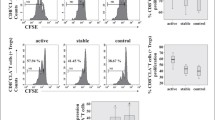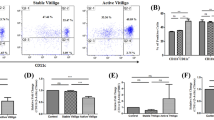Abstract
Accumulating studies have indicated that vitiligo, especially non-segmental vitiligo (NSV), is one kind of autoimmune diseases and CD4+ T cells play important roles in the pathogenesis. However, there have been very limited data on the detailed changes of each of the CD4+ T cell subsets in periphery in active NSV. To clarify this issue, we collected the peripheral blood mononuclear cells (PBMCs) from 30 patients with active NSV and 30 age- and sex-matched healthy controls. The percentages of circulating Th1, Th2, Th17 and Tregs were evaluated using flow cytometry and the expressions of their specific transcription factors T-bet, GATA3, RORγt and FOXP3 at mRNA level and protein levels were qualified by qPCR and flow cytometry, respectively. Meanwhile, the expression levels of IFN-γ, IL-4, TGF-β, and IL-17A in serum were measured. We found that in patients with NSV, the percentages and absolute numbers of circulating Th1 and Th17 were both significantly higher than those of healthy controls, while the percentages of Th2 and Tregs and absolute numbers showed no significant difference compared to healthy controls. Moreover, the ratios of Th1/Tregs and Th17/Tregs in circulation were both statistically elevated in active NSV. Similar results were got in qualification of their corresponding transcription factors at mRNA level and protein levels. Compared with healthy controls, the expression level of IL-17A was significantly increased in serum of patients with NSV, while the productions of IFN-γ, IL-4, TGF-β had no significant change. These data suggested that in circulating CD4+ T cell subsets, Th1 and Th17 played the major role in cellular immunity in the progression of vitiligo. The immune lever in circulation was inclined to effector CD4+ T cells not suppressor CD4+ T cells that may result in the loss of self-tolerance to melanocytes.



Similar content being viewed by others
References
Abdallah M, Lotfi R, Othman W, Galal R (2014) Assessment of tissue FoxP3+, CD4+ and CD8+ T-cells in active and stable nonsegmental vitiligo. Int J Dermatol 53:940–946
Alanko T, Saksela O (2000) Transforming growth factor beta1 induces apoptosis in normal melanocytes but not in nevus cells grown in type I collagen gel. J Invest Dermatol 115:286–291
Basak PY, Adiloglu AK, Ceyhan AM, Tas T, Akkaya VB (2009) The role of helper and regulatory T cells in the pathogenesis of vitiligo. J Am Acad Dermatol 60:256–260
Bassiouny DA, Shaker O (2011) Role of interleukin-17 in the pathogenesis of vitiligo. Clin Exp Dermatol 36:292–297
Ben Ahmed M, Zaraa I, Rekik R, Elbeldi-Ferchiou A, Kourda N, Belhadj Hmida N, Abdeladhim M, Karoui O, Ben Osman A, Mokni M, Louzir H (2012) Functional defects of peripheral regulatory T lymphocytes in patients with progressive vitiligo. Pigment Cell Melanoma Res 25:99–109
Choi H, Choi H, Han J, Jin SH, Park JY, Shin DW, Lee TR, Kim K, Lee AY, Noh M (2013) IL-4 inhibits the melanogenesis of normal human melanocytes through the JAK2-STAT6 signaling pathway. J Invest Dermatol 133:528–536
Edwards LJ, Robins RA, Constantinescu CS (2010) Th17/Th1 phenotype in demyelinating disease. Cytokine 50:19–23
Elela MA, Hegazy RA, Fawzy MM, Rashed LA, Rasheed H (2013) Interleukin 17, interleukin 22 and FoxP3 expression in tissue and serum of non-segmental vitiligo: a case–controlled study on eighty-four patients. Eur J Dermatol 23:350–355
Fitch F, Gajewski T, Nau G, Schell S, Otten G (1988) Nakahara memorial lecture. Regulation of T lymphocyte responses: interactions among receptors. Princess Takamatsu Symp 19:15–27
Geginat J, Paroni M, Maglie S, Alfen JS, Kastirr I, Gruarin P, De Simone M, Pagani M, Abrignani S (2014) Plasticity of human CD4 T cell subsets. Front Immunol 5:630
Grimes PE, Morris R, Avaniss-Aghajani E, Soriano T, Meraz M, Metzger A (2004) Topical tacrolimus therapy for vitiligo: therapeutic responses and skin messenger RNA expression of proinflammatory cytokines. J Am Acad Dermatol 51:52–61
Harbour SN, Maynard CL, Zindl CL, Schoeb TR, Weaver CT (2015) Th17 cells give rise to Th1 cells that are required for the pathogenesis of colitis. Proc Natl Acad Sci USA 112:7061–7066
Imran M, Laddha NC, Dwivedi M, Mansuri MS, Singh J, Rani R, Gokhale RS, Sharma VK, Marfatia YS, Begum R (2012) Interleukin-4 genetic variants correlate with its transcript and protein levels in patients with vitiligo. Br J Dermatol 167:314–323
Ivanov II, Zhou L, Littman DR (2007) Transcriptional regulation of Th17 cell differentiation. Semin Immunol 19:409–417
Jandus C, Bioley G, Rivals JP, Dudler J, Speiser D, Romero P (2008) Increased numbers of circulating polyfunctional Th17 memory cells in patients with seronegative spondylarthritides. Arthritis Rheum 58:2307–2317
Jetten AM (2009) Retinoid-related orphan receptors (RORs): critical roles in development, immunity, circadian rhythm, and cellular metabolism. Nucl Recept Signal 7:e003
Khan R, Gupta S, Sharma A (2012) Circulatory levels of T-cell cytokines (interleukin [IL]-2, IL-4, IL-17, and transforming growth factor-beta) in patients with vitiligo. J Am Acad Dermatol 66:510–511
King C, Tangye SG, Mackay CR (2008) T follicular helper (TFH) cells in normal and dysregulated immune responses. Annu Rev Immunol 26:741–766
Klarquist J, Denman CJ, Hernandez C, Wainwright DA, Strickland FM, Overbeck A, Mehrotra S, Nishimura MI, Le Poole IC (2010) Reduced skin homing by functional Treg in vitiligo. Pigment Cell Melanoma Res 23:276–286
Kotobuki Y, Tanemura A, Yang L, Itoi S, Wataya-Kaneda M, Murota H, Fujimoto M, Serada S, Naka T, Katayama I (2012) Dysregulation of melanocyte function by Th17-related cytokines: significance of Th17 cell infiltration in autoimmune vitiligo vulgaris. Pigment Cell Melanoma Res 25:219–230
Kryczek I, Bruce AT, Gudjonsson JE, Johnston A, Aphale A, Vatan L, Szeliga W, Wang Y, Liu Y, Welling TH, Elder JT, Zou W (2008) Induction of IL-17+ T cell trafficking and development by IFN-gamma: mechanism and pathological relevance in psoriasis. J Immunol 181:4733–4741
Labikova J, Vcelakova J, Ulmannova T, Petruzelkova L, Kolouskova S, Stechova K (2014) The cytokine production of peripheral blood mononuclear cells reflects the autoantibody profile of patients suffering from type 1 diabetes. Cytokine 69:189–195
Lili Y, Yi W, Ji Y, Yue S, Weimin S, Ming L (2012) Global activation of CD8+ cytotoxic T lymphocytes correlates with an impairment in regulatory T cells in patients with generalized vitiligo. PLoS One 7:e37513
Lin M, Zhang BX, Shen N, Dong XJ, Zhang C, Qi XY, Zhu J, Li YZ, Man MQ, Tu CX (2014) Regulatory T cells from active non-segmental vitiligo exhibit lower suppressive ability on CD8+CLA+T cells. Eur J Dermatol EJD 24:676–682
Lopez-Bravo M, Minguito de la Escalera M, Dominguez PM, Gonzalez-Cintado L, del Fresno C, Martin P, Martinez del Hoyo G, Ardavin C (2013) IL-4 blocks TH1-polarizing/inflammatory cytokine gene expression during monocyte-derived dendritic cell differentiation through histone hypoacetylation. J Allergy Clin Immunol 132:1409–1419
Mantel PY, Kuipers H, Boyman O, Rhyner C, Ouaked N, Ruckert B, Karagiannidis C, Lambrecht BN, Hendriks RW, Crameri R, Akdis CA, Blaser K, Schmidt-Weber CB (2007) GATA3-driven Th2 responses inhibit TGF-beta1-induced FOXP3 expression and the formation of regulatory T cells. PLoS Biol 5:e329
Moftah NH, El-Barbary RA, Ismail MA, Ali NA (2014) Effect of narrow band-ultraviolet B on CD4(+) CD25(high) FoxP3(+) T-lymphocytes in the peripheral blood of vitiligo patients. Photodermatol Photoimmunol Photomed 30:254–261
Noble A, Staynov DZ, Kemeny DM (1993) Generation of rat Th2-like cells in vitro is interleukin-4-dependent and inhibited by interferon-gamma. Immunology 79:562–567
Nouri-Koupaee A, Mansouri P, Jahanbini H, Sanati MH, Jadali Z (2015) Differential expression of mRNA for T-bet and GATA-3 transcription factors in peripheral blood mononuclear cells of patients with vitiligo. Clin Exp Dermatol 40:735–740
Paludan SR (1998) Interleukin-4 and interferon-gamma: the quintessence of a mutual antagonistic relationship. Scand J Immunol 48:459–468
Radhakrishnan S, Cabrera R, Schenk EL, Nava-Parada P, Bell MP, Van Keulen VP, Marler RJ, Felts SJ, Pease LR (2008) Reprogrammed FoxP3+ T regulatory cells become IL-17+ antigen-specific autoimmune effectors in vitro and in vivo. J Immunol 181:3137–3147
Rodeck U, Bossler A, Graeven U, Fox FE, Nowell PC, Knabbe C, Kari C (1994) Transforming growth factor beta production and responsiveness in normal human melanocytes and melanoma cells. Cancer Res 54:575–581
Sharma MD, Hou DY, Liu Y, Koni PA, Metz R, Chandler P, Mellor AL, He Y, Munn DH (2009) Indoleamine 2,3-dioxygenase controls conversion of Foxp3+ Tregs to TH17-like cells in tumor-draining lymph nodes. Blood 113:6102–6111
Tu CX, Jin WW, Lin M, Wang ZH, Man MQ (2011) Levels of TGF-beta(1) in serum and culture supernatants of CD4(+)CD25 (+) T cells from patients with non-segmental vitiligo. Arch Dermatol Res 303:685–689
Vaccaro M, Cannavo SP, Imbesi S, Cristani M, Barbuzza O, Tigano V, Gangemi S (2015) Increased serum levels of interleukin-23 circulating in patients with non-segmental generalized vitiligo. Int J Dermatol 54:672–674
van Geel NA, Mollet IG, De Schepper S, Tjin EP, Vermaelen K, Clark RA, Kupper TS, Luiten RM, Lambert J (2010) First histopathological and immunophenotypic analysis of early dynamic events in a patient with segmental vitiligo associated with halo nevi. Pigment Cell Melanoma Res 23:375–384
Wang CQ, Cruz-Inigo AE, Fuentes-Duculan J, Moussai D, Gulati N, Sullivan-Whalen M, Gilleaudeau P, Cohen JA, Krueger JG (2011) Th17 cells and activated dendritic cells are increased in vitiligo lesions. PLoS One 6:e18907
Wang Z, Wang Z, Wang J, Diao Y, Qian X, Zhu N (2016) T-bet-expressing B cells are positively associated with Crohn’s disease activity and support Th1 inflammation. DNA Cell Biol. doi:10.1089/dna.2016.3304
Wankowicz-Kalinska A, van den Wijngaard RM, Tigges BJ, Westerhof W, Ogg GS, Cerundolo V, Storkus WJ, Das PK (2003) Immunopolarization of CD4+ and CD8+ T cells to Type-1-like is associated with melanocyte loss in human vitiligo. Lab Invest 83:683–695
Wurtz O, Bajenoff M, Guerder S (2004) IL-4-mediated inhibition of IFN-gamma production by CD4+ T cells proceeds by several developmentally regulated mechanisms. Int Immunol 16:501–508
Yang L, Wei Y, Sun Y, Shi W, Yang J, Zhu L, Li M (2015) Interferon-gamma inhibits melanogenesis and induces apoptosis in melanocytes: a pivotal role of CD8+ Cytotoxic T lymphocytes in vitiligo. Acta Dermato-Venereol 95:664–670
Zhang BX, Lin M, Qi XY, Zhang RX, Wei ZD, Zhu J, Man MQ, Tu CX (2013) Characterization of circulating CD8+ T cells expressing skin homing and cytotoxic molecules in active non-segmental vitiligo. Eur J Dermatol EJD 23:331–338
Zhou L, Li K, Shi YL, Hamzavi I, Gao TW, Henderson M, Huggins RH, Agbai O, Mahmoud B, Mi X, Lim HW, Mi QS (2012) Systemic analyses of immunophenotypes of peripheral T cells in non-segmental vitiligo: implication of defective natural killer T cells. Pigment Cell Melanoma Res 25:602–611
Zhou L, Shi YL, Li K, Hamzavi I, Gao TW, Huggins RH, Lim HW, Mi QS (2015) Increased circulating Th17 cells and elevated serum levels of TGF-beta and IL-21 are correlated with human non-segmental vitiligo development. Pigment Cell Melanoma Res 28:324–329
Acknowledgments
The authors thank all patients and healthy donors who participated in the current study.
Author information
Authors and Affiliations
Corresponding author
Ethics declarations
The authors declare that they have no conflict of interest. This work was supported by the grants from the National Natural Science Foundation of China (No. 81401351) and Health and Family Planning Commission of Jilin Province (2012Z079). All procedures performed in studies involving human participants were in accordance with the ethical standards of the institutional and/or national research committee and with the 1964 Helsinki declaration and its later amendments or comparable ethical standards. This article does not contain any studies with animals performed by any of the authors. Informed consent was obtained from all individual participants included in the study.
Electronic supplementary material
Below is the link to the electronic supplementary material.
Rights and permissions
About this article
Cite this article
Zhen, Y., Yao, L., Zhong, S. et al. Enhanced Th1 and Th17 responses in peripheral blood in active non-segmental vitiligo. Arch Dermatol Res 308, 703–710 (2016). https://doi.org/10.1007/s00403-016-1690-3
Received:
Revised:
Accepted:
Published:
Issue Date:
DOI: https://doi.org/10.1007/s00403-016-1690-3




